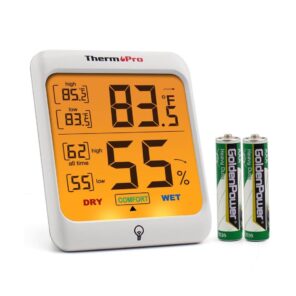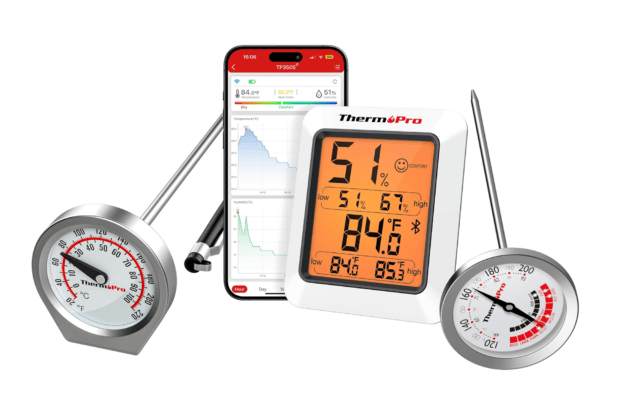Table of Contents
Keeping an eye on the ideal temperature and humidity levels in a classroom is essential. Sudden changes in the weather can impact the health of both the students and teachers.
Therefore, It is important for us to understand the advantages of maintaining/controlling an ideal temperature in order to make a suitable environment for learning. There are so many factors to keep in mind and this blog lays emphasis on how schools can monitor room temperatures throughout the year to ensure their students and teachers are happy and comfortable.
The Effects of Classroom Humidity Levels on Teachers and Students
It is important to maintain classroom relative humidity at the recommended levels. Mostly, 40% – 70% is the best humidity level for a learning environment. Maintaining a higher or lower humidity level in the classroom lead to the following:
- Allergens – High humidity can cause pollen, dust, and mold to form in the classroom.
- Spread of disease – If a classroom has high relative humidity, there is a good environment for the growth of pathogens and the spread from one person to another.
- Asthma – High humidity levels also trigger asthmas in new patients and those that have contracted it before. Therefore, it becomes necessary to have a well-controlled environment to provide the best learning environment, even for those with asthma.
- Mold growth – A high humid environment is perfect for the growth of molds and is a trigger for many diseases. Therefore, it is best to maintain an optimum level to prevent growth.
- Spread of diseases – A low relative humidity can spread airborne diseases. Aerosols containing bacteria can travel in the air easily and get into students’ and teachers’ bodies.
- Discomfort – Maintaining low humidity can be a health risk in the classrooms. A completely dry environment may have impacts such as itchy and dry mucus and throat membranes. Also, the eyes and skin, in general, can feel itchy and dry.
Relations between Temperature and School Work Performances
It is important to know the classroom temperature regulations that will provide learners and teachers the best environment. Both low and high temperatures in a classroom can have adverse effects on the ability to learn. Both teachers and students need to have a good learning environment for the best results. So, how does low or high temperature affect learning in schools:

According to Harvard Kennedy School, there is a huge correlation between classroom temperatures and the ability to learn. For instance, students find it difficult to concentrate when the temperatures are extreme. The human body tends to trigger the body to react to a rise in temperature. That keeps both the brain and body away from learning as they try to find comfort.
Also, studies have proved that classroom temperatures have an impact on how human memory works. There is a low concentration level when temperatures are high, meaning that the ability to grasp ideas in class is grossly affected.
It also contributes to a high level of tiredness. Students and teachers feel tired when the temperatures are high. Overall, body fatigue is another thing that can distract learners from the classroom. It means the ability to grasp content is affected, and the learning process becomes difficult.
Besides, low temperatures combined with high humidity can also lead to poor school performance. Other than causing mold growth, high humidity brings about the dust that leads to sneezing. It can escalate to other diseases or even have an impact on how students concentrate in class.
Optimal Temperature and Humidity Range for School Classroom
Schools must maintain an optimal learning environment both for students and teachers. That means they have to ensure things like temperature and humidity do not go higher than what health experts recommend for proper classroom comfort.
Thus, most schools are beginning to install electric equipment that can help to maintain good conditions. For instance, they make sure there are things like air conditioners, dehumidifiers, and room heating systems to keep everything in control.
However, optimization has not been easy because schools find it difficult to meet the costs of maintaining this equipment and paying for utilities. However, it is inevitable since the results of having non-optimized weather conditions can manifest in the students’ performances.
Although there are no legally allowed working environment temperatures and humidity levels, schools must take responsibility, some authority organizations such as the U.S. Environmental Protection Agency’s (US EPA) Indoor Air Quality (IAQ) Tools for schools Action Kit recommends that indoor relative humidity levels should ideally be between 30-50%, or at least below 60%. And classroom temperatures should be maintained between 68 degrees and 75 degrees Fahrenheit(20~24 Celsius) during the winter months and between 73 degrees and 79 degrees Fahrenheit(23~26 Celsius) during the summer month.
In a nutshell, maintaining optimal temperatures and humidity contributes to class attendance. High or low levels of these weather conditions can cause or increase the spread of some diseases.
How to Monitor Classroom Temperature and Humidity Level Easily?
The easiest way to measure the temperatures and humidity of a classroom is by using a thermometer and hygrometer, respectively. It is essential to understand the optimal levels so that you can compare the results and determine the levels.
There is regular humidity measuring equipment that has been great at measuring the levels in classrooms. A simple hygrometer has been applicable in determining these conditions.
Indoor thermometers and hygrometers from ThermoPro can help you monitor and keep the temperature and the humidity levels in a classroom easily. It uses electronic means to measure and record these conditions constantly.
-
Sale Product on sale
 ThermoPro TP53
ThermoPro TP53$19.99$13.99 $14.83Rated 4.65 out of 5 based on 31 customer ratings
Since this is a digital thermometer, there is no need to record and calculate the findings to develop an average classroom temperature Celsius or humidity level. The thermostat does everything for you. All you need to do is place it in the right place, usually, one-meter above the floor. Leave it for about 3 minutes and read the temperature.
Tips to Control Classroom Temperature and Humidity
Providing students and teachers with the perfect learning environment does not only mean installing the right systems. It begins with the construction of schools and the measures taken to ensure classroom environments are excellent.

Also, there is a need to install energy-efficient environmental control systems. These include things like thermometers, air conditioners, and dehumidifiers to help keep these conditions optimal. Here are tips that can be helpful:
Proper ventilation
There are two ways that schools can ventilate buildings to reduce classroom temperature problems. Schools can adopt proper ventilation as a way of controlling the room temperature using the outside temperatures to make the environmental conditions bearable. These are day time and night ventilation programs. When a school chooses daytime ventilation, it means they have to open windows and doors to let in natural air balance the classroom environment.
Also, they can try night ventilation, which also works perfectly. It involves opening windows and doors at night to let in as much natural air, which helps to cool a building during the day. It means that you will require less air to cool the environment when it turns hot.
Raising temperatures
When it comes to humidity, raising room temperatures works perfectly. Here, heating systems can get introduced as a way of controlling the falling temperatures. The best way to do it is by installing an air conditioner with re-heat. That will allow you to change the settings and will enable the equipment to produce the warmth required.
Also, opening windows helps to reduce moisture levels in the classroom. Even if it is too cold outside, opening windows for at least 15 minutes a day will maintain lower humidity and provide a good learning environment.
Conclusion
There are many benefits of maintaining optimal temperature and humidity in a classroom. Other than contributing to good health, it ensures that classroom sessions can be productive. Maintaining proper conditions ensures there is a better mental focus that is key to better performance. The tips in this article are effective in providing the best environment for students and teachers.






















